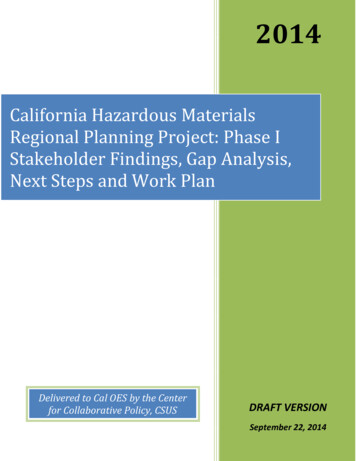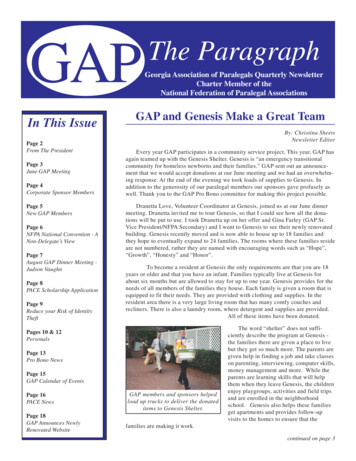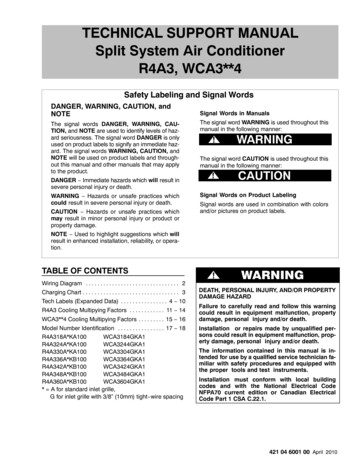
Transcription
2014California Hazardous MaterialsRegional Planning Project: Phase IStakeholder Findings, Gap Analysis,Next Steps and Work PlanDelivered to Cal OES by the Centerfor Collaborative Policy, CSUSDRAFT VERSIONSeptember 22, 2014
TABLE OF CONTENTSExecutive Summary . 2Introduction . 3The Research and Stakeholder Issues Assessment Process . 4Stakeholder Interviews and Assessment. 9The Stakeholder Workshop. 14Recommendations—Moving Forward. 251. Develop a Project Management Governance Structure Engaging Multiple Stakeholders. 252. Sustain Executive Support . 273. Strategically Approach State Hazmat Regional Planning . 28The Proposed Work Plan and Next Steps. 29Phase I: May through September 2014 [Completed] . 30Phase II: November 2014 through March 2015 (estimated depending upon start time and contracting) . 31Phase III: April through June 2015 (depending upon start time; may be through summer). 31Phase IV: July 2015 through September 2015 (approximately) . 32Phase V: Out Years (following this one year project as successor effort) . 32Acronyms . 33This document was developed using funds from a Hazardous MaterialsEmergency Preparedness Grant. Any views, findings, conclusions orrecommendations expressed in this document do not necessarily representthose of the federal government.CALIFORNIA HAZARDOUS MATERIALS REGIONAL PLANNING PROJECTINITIAL PHASE I FINDINGS, NEXT STEPS & FUTURE WORK PLAN DRAFT1
EXECUTIVE SUMMARYRegional hazardous materials emergency planning is required under federal law, whichmandated the establishment of state emergency response commissions and Local EmergencyPlanning Committees. Recent high-profile accidents have focused attention on the need forCalifornia to improve regional hazardous material emergency planning. Cal OES contracted withCalifornia State University, Sacramento Center for Collaborative Policy to provide strategicdevelopment, stakeholder management, work group facilitation, and document developmentfor a multi-phase Regional Hazardous Materials Planning project.This document is the result of Phase 1 of that project. Phase 1 was completed in September2014 and included: a detailed review and assessment of the available literature on hazardousmaterials emergency planning; interviews and meetings with key stakeholders; a workshop thatprovided feedback and recommendations; and, a recommended work plan and governancestructure for the remaining phases of the project.Significant findings from Phase 1 include: The State Emergency Response Committee is in a unique position to provide essentialleadership, resources, and guidance.Statewide, consistent standards, with some degree of local flexibility, are needed.Predictable, reliable funding for regional hazardous materials emergency planning andfor the effective functioning of Local Emergency Planning Committees is critical.The authorities, roles, and requirements of the many confusing and overlappinghazardous materials plans need to be clarified.There is a need for useful, functional guidance, tools, or templates for preparing andupdating regional hazardous materials emergency plans.The next major steps in the project are: Form an advisory group of key stakeholders, as a ‘Core Planning Team’.Develop a model template, guidance, toolkit, or other type of planning product that canprovide needed assistance and guidance for regional hazardous materials emergencyplanning.Hold workshops throughout the state to obtain feedback on the planning products.Apply the prototype planning product to a regional hazardous materials emergency planin a pilot test.2
INTRODUCTIONRegional hazardous materials (hazmat) planning is required under the 1986 federal law, theEmergency Planning and Community Right-to-Know Act (EPCRA). EPCRA required theestablishment of state and tribal emergency response commissions (SERCs and TERCs,respectively) and local emergency planning committees (LEPCs). Although required since 1986,the law did not provide funding for these activities and the ability of LEPCs to function hasdepended on uncertain sources of funding and on the ability of local agencies to provide thepersonnel and resources. The difficulty in regional hazmat planning is increased by thegeographic size, economic health, and demographic differences of the six California regionalplanning areas.1 These difficulties were compounded by the inactivity of the California SERC,which was dormant for several years, until recently.Recent high-profile hazmat incidents have focused attention on the need for California to revivesupport for hazmat regional planning. Some of the notable incidents include: the San Bruno GasExplosion; the West, Texas fertilizer explosion; the Richmond Refinery explosion and fire; and anumber of incidents involving hazardous materials being transported by rail. The substantialincrease in the amount of a particularly hazardous form of crude oil being shipped by railthroughout the continent also has led to several serious accidents. California’s response tothese events has included: The Interagency Refinery Task Force developed recommendations for improving publicand worker safety at oil refineries.The Interagency Rail Safety Working Group developed recommendations for oil-by-railsafety in California.The California SERC has been revitalized to encourage and assist with emergencypreparedness and planning throughout the State.Additionally, Cal OES contracted with California State University, Sacramento Center forCollaborative Policy (CCP) using monies from the Hazardous Materials Emergency Preparedness(HMEP) grant to assist Cal OES with strategic development, stakeholder management, workgroup facilitation, and document development for Phase I of a multi-phase Regional HazardousMaterials Planning (RHMP) project.This document provides: 1Initial research into hazardous materials planning efforts within California and nationallythat support and inform the development of a standardized planning process, template,and guidance.The six regional LEPC planning areas are coincident with the six Cal OES mutual aid regions.3
Initial assessment of current issues, policies, and trends based on research, interviews,and meetings with key stakeholders. Information from a workshop of key stakeholders that provided feedback on theresearch and direction for the statewide project. A recommended work plan and governance structure for development of standardizedLEPC Hazardous Materials Regional Response Plans, based on an assessment of theresearch and stakeholder input.This document is intended to assist ‘next phase’ planning efforts, to summarize the CCPassessment process, and reflect on the findings received and to allow internal discussions anddecision making to occur regarding how to proceed on subsequent elements of the longerproject. An addendum to this document provides the evaluations and comments collected fromparticipants at the State HMRP Workshop held on September 10, 2014, at Cal OESheadquarters.THE RESEARCH AND STAKEHOLDER ISSUES ASSESSMENT PROCESSCCP routinely carries out assessments as the first stage in the collaborative consensus buildingand data gathering process. The purpose of this assessment is to provide a baseline of key dataand identification of past and current planning efforts that can be built upon and potentialissues to be addressed; an analysis of key stakeholders to determine who needs to be at thetable; uncovering key perspectives, viewpoints, and recommendations from stakeholders; andthe development of a preliminary process design to begin detailed future phases for the HMRPproject.Research and Document Review FindingsAs a first step, CCP staff reviewed more than 25 documents identified via the Internet orsuggested by Cal OES and other stakeholders. The purpose of the document review was toidentify best practices, methods, techniques, processes, systems, tactics, and approaches thathave been successful and can be helpful in this project development. The layout andconfiguration of a planning document (or an element within a document) can assist in itsusefulness, so during the document review attention was also given to the format, accessibility,and usefulness in providing information. This document review was a snapshot of the availableliterature rather than an exhaustive review. The summary document includes online links to allof the referenced documents. The documents included: federal advisories, reports andrecommendations, federal and state guidance, state tool kits, primers and backgroundinformation, hazmat area plans, regional plans, county plans and state plans, documentsdescribing the legal basis for hazmat planning, and federal and state safety alerts, findings and4
recommendations for oil transport and oil refineries. The research identified best practices,example plans and prototypes, useful formats, successful policies, issues and trends, potentialroles of key stakeholders, and existing planning efforts that may be incorporated into or used asmodels for hazardous materials regional planning in California.Key aspects of the some of the reviewed documents were presented by CCP staff at theSeptember 10, 2014 HMRP Workshop and are provided below to exemplify the type ofinformation that currently exists for consideration in the development of the California HMRP.The review document separates the documents into the following categories: (1) preparedness,(2) planning, (3) area plans, (4) regional plans, (5) state plans, (6) legal basis, (7) rail transport,(8) fixed facility, and (9) additional documents for review. For more information on these andthe other documents included in the CCP document review process, refer to the attachedreport titled Cal OES Regional Hazardous Materials Planning Document Review.Key Points from Documents Reviewed:1. U.S. DHS National Protection and Programs Directorate, U.S. Dept. Labor OccupationalSafety and Health Administration, U.S. EPA Office of Solid Waste and Emergency ResponseExecutive Order 13650 Actions to Improve Chemical Safety and Security – a SharedCommitment2May 2014 Commits federal agencies to specific activities to improve operational coordination, tomodernize regulations, and to identify best practices. Contains a link to an online repository of best practices. Useful Glossary of Terms with good descriptions of relevant programs and links topertinent documents, laws, etc. Useful appendix containing a list of resources and applicable links. Lists significant recent chemical incidents in the U.S. Contains section on frequent topics and themes heard during stakeholder meetings.2. U.S. Environmental Protection AgencyMeasuring Progress in Chemical Safety: A Guide for Local Emergency PlanningCommittees and Similar GroupsDocument is undated, but website was updated on March 16, 2014 Provides examples and planning approaches. Discusses how to evaluate and measure LEPC performance.3. U.S. Environmental Protection Agency2Executive Order (EO) 13650 - Improving Chemical Facility Safety and Security - was issued by President Obamaon August 1, 2013.5
2008 Nationwide Survey of Local Emergency Planning CommitteesDocument undated, but survey conducted in 2008 Survey was performed electronically, which may be a useful technique for furtherphases of the HMRP project. Survey questions are available in document. LEPCs that have had hazmat incidents were the most active LEPCs. LEPCs report needing assistance in public outreach and communication. LEPCs have requested that the U.S. EPA prepare a compilation of best practices oroperational guidance.4. State of California, Governor’s Office of Emergency ServicesHazardous Materials Toolkit: Parts 1-4January 2014 Provides valuable reference tools. Includes concept of operations for hazmat. Includes agency roles.5. Texas Governor’s Division of Emergency ManagementLocal Emergency Planning Committee (LEPC): A Primer for Local Planning for HazardousMaterialsJuly 26, 2006 Describes an effective working management structure for an LEPC. Describes attributes of a productive LEPC. Good format with well-organized information on legal basis, LEPC duties, reportingrequirements, levels of compliance, hazards analysis, risk management, and exercisesand training. Extensive, useful appendices, including some templates.6. California Governor’s Office of Emergency Services; the Cities of Oakland, San Francisco, andSan Jose; the Counties of Alameda, Contra Costa, Marin, Napa, San Mateo, Santa Clara,Santa Cruz, Solano, and SonomaSan Francisco Bay Area Regional Emergency Coordination Plan: RECP Hazardous MaterialsSubsidiary PlanMarch 2008 LEPC coordination plan. Roles and responsibilities for regional response.6
7. Region IV Local Emergency Planning CommitteeHazardous Materials Emergency PlanSeptember 2011 LEPC coordination plan. Roles and responsibilities for regional response. Lists of trained personnel and emergency response equipment.8. State of California, California Department of Fish and Wildlife, Office of Spill Prevention andResponseCalifornia State Oil Spill Contingency Plan2013 Initial section is in a convenient format relating to who has to report and the contactinformation for reporting. Clear description of authorities, contingent on the site of oil spill. Useful section on capabilities and limitations of responding agencies. Statutory requirements appendix is a functional and accessible format.9. National Association of SARA Title III Program OfficialsNASTTPO Guidance on CFATS Emergency PlanningJanuary 13, 2008 Comparison of key requirements of CFATS, EPCRA, and RMP.3 Effective format for showing overlaps and gaps in coverage by the three laws compared.10. The Pipeline and Hazardous Materials Safety Administration, U.S. Dept. TransportationSafety Alert – Preliminary Guidance from Operation ClassificationJanuary 2, 2014 Rail transport safety alert.11. Congressional Research Service , John Frittelli , Anthony Andrews, Paul W. Parfomak, RobertPirog, Jonathan L. Ramseur, Michael RatnerU.S. Rail Transportation of Crude Oil: Background and Issues for Congress – Document No.7-5700May 5, 2014 Summary of significant oil by rail derailments in U.S. and Canada in 2013 and 2014. Discussion of issues related to the safety of rail transport of crude oil.3CFATS is the Chemical Facility Anti-Terrorism Standards; EPCRA is the Emergency Planning and CommunityRight-to-Know Act (part of SARA Title III); and, RMP is the Risk Management Plan Rule (part of the Clean AirAct amendments).7
Little discussion of the issues of state and local response to accidents in a regulatoryenvironment where there is federal oversight and a lack of specific, timely information.12. State of California, Interagency Rail Safety Working GroupOil by Rail Safety in California: Preliminary Findings and RecommendationsJune 10, 2014 Describes scope of oil shipping in the state by rail. Describes recent oil-by-rail accidents. Identifies high hazard areas not covered by emergency hazmat. Includes recommendations for emergency preparedness and response programs.13. California Interagency Working Group on Refinery SafetyImproving Public and Worker Safety at Oil Refineries: Report of the Interagency WorkingGroup on Refinery SafetyFebruary 2014 Report provides list of California refineries with local regulatory jurisdictions, includingCUPAs, Air Districts, and CalOSHA units. Contains section on the major themes in stakeholder perspectives, including labor,communities, industry, and regulatory agencies. Contains a list of specific recommendations regarding refinery safety and response. Speaks to specific planning issues for oil refineries. The document includes a table with ahelpful format showing the responsible agencies, applicable regulations, and purpose ofthe regulatory requirements.Additional Documents to Review:In addition to the summary of documents reviewed, the research document includes a list of“Additional Documents for Future Review.” These documents may be useful as the HMRPproject moves forward.Quick Summary: Key ‘Take-Aways’ from the Research Effort: Because of the increase in the shipment of crude oil by rail, California must be betterprepared for emergency response to accidents involving rail transport.There are several documents that offer prototypes, templates, or formats that couldserve as models for preparing, reviewing, and updating regional hazmat plans.There are several guidance documents that address key hazmat planning concepts thatcould facilitate and simplify the regional hazmat plan development process.California could develop an online repository of guidance documents, formats,templates, and best practices from other sources to support the development of regionalhazmat plans in California.8
California can learn from the regional hazmat planning efforts of other states.LEPCs are likely to need assistance in public outreach and communication.LEPCs have requested a compilation of best practices or operational guidance.STAKEHOLDER INTERVIEWS AND ASSESSMENTTo gather critical information for this assessment, the CCP conducted confidential individualand group interviews involving 18 stakeholders representing federal, state and localgovernmental agencies, local government associations, tribal government liaisons, and keyCal OES staff. The objective of these interviews was to: Identify hazmat roles and responsibilities;Determine stakeholder perspectives on hazmat planning in California and on theoverlaps and gaps of the various planning requirements;Discover current plans, best practices, tools, and documents that are available forhazmat emergency planning;Understand potential barriers that need to be addressed;Obtain suggestions on coordination and project management; and,Identify additional key leaders that could contribute to the HMRP project.A larger group of stakeholders identified by Cal OES staff in coordination with CCP were sent anintroductory e-mail from Cal OES Hazmat Deputy Chief Thomas Campbell. This e-mail alsoincluded an invitation to participate in the September 10 workshop at Cal OES. Additionalemails from Adam Sutkus and Caryn Woodhouse, CCP, notified selected recipients of thepending assessment interviews that would be conducted by CCP. These e-mails included aquestionnaire so invitees knew in advance the topics to be discussed during the interview. Acopy of this email including the list of addressees is included in the CD archive of this project’sdeliverables and products.Keeping in mind that these interviews were confidential and the assessment results aregeneralized, the key results of the assessment interviews are summarized below with a focuson themes, needs, and key issues.Hazardous Materials Roles:The interviewees were spread over representative positions/functions in California hazardousmaterials planning and emergency response, including: federal EPA, Cal/EPA, Calif. Dept. ToxicSubstances Control, LEPC Chairs, and Cal OES personnel. The interviewees that were at the locallevel demonstrated one of the main issues with the current, unfunded LEPC mandate – theinterviewees served a dual role, one full-time paid and one squeezed in as opportunity allowed.9
For example, the LEPC Chairs include a CHP member, and more than one local or county firedepartment. This issue is described more fully in the gaps and barriers discussion below.Best Practices, Useful Tools, and Helpful Documents:The stakeholder interviews identified existing and current best practices, successful tools, andhelpful documents/guidance that could be used in the development or update of a hazmatregional plan (many of these are described more fully in the document review summary). Theinterviews also pointed out a desire for additional tools that were vetted, documented, shared,and accessible. In general, the respondents that were involved in LEPC activities desired toolsthat were easy to access and use, including prototypes of emergency plans, backgroundinformation in useful, user-friendly formats, and guidance on public communication. All of thetools and documents that were identified were included in the document review (describedpreviously and attached).Gaps, Barriers and Challenges in Hazmat Planning:The stakeholder interviews revealed many perceived gaps and barriers in hazardous materialsplanning in California. In particular, the interviews showed: State Emergency Response Committee: The LEPCs need assistance and guidance fromthe SERC. One commentator suggested that Cal OES, through the SERC, needs to retainthe statewide ‘convening’ role because there is no other entity that can serve thisfunction. There was strong sentiment that the SERC should continue to function andbegin to offer stronger leadership, guidance, and resources. Cal OES must demonstratea commitment to follow through on the revived SERC with clear accountability to do so.The membership issues need to be settled so that the SERC can move forward, perhapslimiting participation to emergency response organizations/agencies and includingadditional LEPC members in the SERC, as well as tribal representation. The SERC couldalso provide coordination between regions. Some felt that there is almost too muchplanning, but no coordination.Funding: There was considerable comment in this area. Funding is a huge challenge. Thechanging rules for HMEP grants need to be addressed. The U.S. EPA will be developing asmall grants program as part of Executive Order 13650, and these will be available toLEPCs. Cal OES should follow up on this. Most of the funding comments fell into threeareas of concerns. The first is that there is no funding provided for LEPC activities. Thesecond is that if local agencies release personnel to take part in the LEPC or in trainingrelated to emergency hazmat response and planning, there is no funding for anyoneelse to perform that person’s regular job or to pay for overtime or travel. The third areais in the inequity between regions – some regions have a higher density of fixed facilities10
4that can be assessed fees to support hazmat activities while other regions have fewfixed facilities, but high exposure due to transport of hazardous materials through theregion or to illegal operations involving poorly managed hazardous substances.Participation in the LEPCs: Although mandated by federal law, LEPCs are volunteerorganizations. Participation is inconsistent and is limited by resource and personnelshortages, and the large geographic extent of the regions. Some smaller districts do notparticipate. With smaller districts, there is more turnover and many changes inpersonnel, making it hard to ensure awareness and involvement.Focus of the LEPCs: Do not make anything a one-size-fits-all. Let the “real” hazards leadthe conversation. Do not focus on oil-by-rail to the exclusion of the most frequent ormost likely hazard across many chemical risks.Regional and Statewide Exercises: Some of the commentators made compellingarguments for exercises and drills. Even if there is a well-written regional hazmat plan, itis not effective without awareness, evaluation, and testing. An annual LEPC exercisewould be helpful, even a one-day table top exercise. Some LEPC members cannotparticipate in exercises and drills because of the time and resources needed toparticipate.Training: The LEPCs need training. There is training offered at CSTI but even if funds areavailable for training there is no budget for travel or overtime. There needs to be asolution for backfilling and overtime during training. Most found the CSTI on-the-roadclasses useful, but have suggested that there should be additional regional training andnew regional training centers established. One suggested establishing a COBRA-like4training center in Sacramento or Los Angeles to provide a more hands-on, in-depthtraining for complex responses.Format of the Tools Needed: The LEPCs need a better way to distribute information andhave access to tools and documents. A lot of smaller agencies have been sharing areaplans, forms, and protocols. These should be cross-referenced and available widely.There needs to be an electronic library that the regions can use to share documents andexamples. The requests concerning the format of the tools needed was broad andincluded:o A checklist for effectively evaluating and updating the LEPC plans.o Online examples.o Templates that include the required elements, but allow regions to individualizethem for the hazards and structure of each region.o A cross-walk tool.o Canned public messages that can be made to fit the situation as needed.COBRA is the Center for Domestic Preparedness Chemical, Ordnance, Biological, and Radiological (COBRA)training facility located in Anniston, Alabama.11
5o A primer clearly describing all of the elements of LEPC operations and plans.o A document or tool providing planning ‘guiding principles.’o There needs to be a two-way portal for hazmat information.o A system to broadcast of hazmat incidents so others could learn and share.Plan Development and Updates: There needs to be a streamlined process to develop aregional plan but not a generic, off-the-shelf plan. The regional plans need to beupdated. Some local agencies do not understand the value of a regional plan. Oneregion does not have a regional plan. In that region, there are 13 area plans, many ofwhich are cookie-cutter and not useful, but no regional plan to tie them together andshow all the resources available. There is no funding to do so. There needs to beguidance on plan revisions.Rail and Fixed Facility Issues: There is a focus on oil-by-rail, but there are other hazardspresented by transporting hazardous substances (rail, highway, ship, pipeline, etc.) andby fixed facilities. There needs to be timely awareness of what is traveling through aregion and what is being used in a region so that plans can be customized as needed. Atleast one region has a rail representative serving on the LEPC. Communications with therailroads is an issue. Transportation corridors transit multiple counties and it is often notalways clear in whose jurisdiction an incident occurs.Planning Opportunities to Coordinate Key Activities: A consistent theme that becameapparent was the multiple legislative and planning changes that have emerged in recentyears—most urgently the increase in the OSPR5 authority and planning requirements.This ‘double edged sword’ needs to be transparently discussed and addressed, since alack of coordination of the planning beginning by OSPR with other existing planningneeds could result in significant confusion; yet, the changes at OSPR bring much neededfunding, staffing, and attention to the larger challenge of chemical spills overall. Theterminology regarding various plans is also overlapping and confusing. The positive viewis that a window of opportunity has opened now to finally align and coordinate plansand planning requirements that have been confusing to many in the field.Additional Comments:o Because of topography, communications systems do not work well.o Communication is vital– Cal OES and the SERC need to use email, webinar, phonecalls to push out ideas and ask for input.o Communication and face-to-face meetings before an emergency helps withcoordination during an emergency.o There is a tension between community-right-to-know and protecting informationabout critical infrastructure and confidential business information.OSPR is the California Office of Spill Prevention and Response.12
o Talk to Arizona and Nevada, which have similar challenges in making LEPCsfunctional.o Wide-spread pending retirements will raise issues of LEPC sustainability,particularly for rural areas statewide.o LEPCs need a stronger Mutual Aid Regional Advisory Committee (MARAC) link.o The needs and resources of full-time, part-time, paid, volunteer, rural, and urbanLEPCs are different.o There needs to be consistency regarding notification, reporting, and training.o One interviewee proposed that Cal OES be in charge of hazmat requirementsthroughout the state. Cal OES should be the central hub for notification andreporting and the information should go laterally from Cal OES.o Some of the interviewees suggested additional people that should be included orconsulted in future phases of the HMRP project. These names are listed in theattached Key Stakeholder Interview Summary.Quick Summary: Key ‘Take Aways’ from the Assessment Effort: Funding is an enormous challenge and must be addressed.The revitalized SERC must continue to function and become successful. The SERC mustprovide leadership, resources, guidance, and statewide consistency.There needs to be a streamlined proc
support for hazmat regional planning. Some of the notable incidents include: the San Bruno Gas Explosion; the West, Texas fertilizer explosion; the Richmond Refinery explosion and fire; and a number of incidents involving hazardous materials being transported by rail. The substantial










